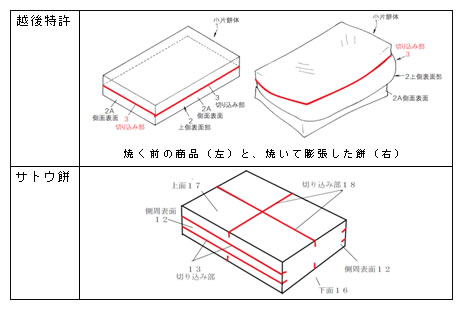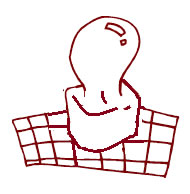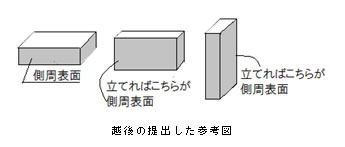Dispute Of Construing Claim Term As “Not On X But On Y” Or “On Y That Is Not X”? Sato’s Rice Cake Case
Background Of Case
EchigoSeika Co., Ltd. has been a proprietor of Japanese Patent No. 4,111,382 (‘382 patent) with respect to the invention of rice cake, while Sato Foods Industries Co., Ltd. had sold rice cake called “Sato’s Kiri-Mochi” (Sato’s rice cake) for many years.
Probably due to anxiety about favorable sales of Sato’s rice cake, EchigoSeika filed a lawsuit with the Tokyo District Court in 2009 against Sato for infringement upon ‘382 patent to seek injunction etc. Both pieces of rice cake, ‘382 patent and Sato, are compared with each other as shown below. The “slits” at issue are formed only on a side surface of ‘382 patent, while such “slits” are not only formed on a side surface but also formed in a cross shape on top and bottom surfaces of Sato’s rice cake.

Probably due to anxiety about favorable sales of Sato’s rice cake, EchigoSeika filed a lawsuit with the Tokyo District Court in 2009 against Sato for infringement upon ‘382 patent to seek injunction etc. Both pieces of rice cake, ‘382 patent and Sato, are compared with each other as shown below. The “slits” at issue are formed only on a side surface of ‘382 patent, while such “slits” are not only formed on a side surface but also formed in a cross shape on top and bottom surfaces of Sato’s rice cake.

For what purpose have the slits been formed?
According to the slits on rice cake, a swelling position not adjustable up to that time could be identified, and a breaking-out force could also be reduced, thereby positively preventing the rice cake from swelling to the extent that the breaking-out contents extend to grill meshes.
To High Court
The counter argument of the defendant, Sato, was accepted by the Tokyo District Court, and it was held that “Sato’s rice cake does not fall within the technical scope of ‘382 patent, which led to non-infringement. The defeated patentee, EchigoSeika, filed an appeal with the IP High Court. The High Court reversed the judgment of non-infringement to infringement, and the patentee reversely prevailed. Besides the injunctive relief, a high value of monetary relief, 1,485 million yen, had been sought in damages by the patentee. What caused such a reversal of the judgment?
What Are Points At Issue?
As shown in the above figure, ‘382 patent has the claim reciting one “slit” formed on an entire circumference of side surfaces. More specifically, the claim recites as follows:
| (the rice cake) comprising at least one slit or groove formed on a circumferential side surface as an upright side surface of an upper-side surface portion of the piece of block other than a bottom surface for placement or a flat top surface such that the at least one slit or groove is extended in length along a circumferential direction that is a direction in line with the upright side surface・・・ |
Why does the claim recite “bottom surface for placement” or “flat top surface”? For the rice cake having the form of a rectangular solid as shown in the above figure, claim term, “lower surface,” “upper surface,” “side surface” appears to be sufficient for identifying each surface of the rice cake. If the rice cake is placed in an upright position for grill, a “side surface” cannot be distinguished from other surfaces merely by viewing the rice cake in the selling stage. Such a claim construction is in line with that provided by the IP High Court later.
Two Options Of Claim Construction
Two options of claim construction can be established for the relevant recitations.
| Claim Construction |
| Slit is formed not on bottom or top surface but on “circumferential side surface only.” |
| Infringement Or Non-Infringement |
| Rice cake having slit formed on bottom or top surface not infringes upon ‘382 patent. |
| Claim Construction |
| Slit is formed on “circumferential side surface” that is not bottom or top surface. |
| Infringement Or Non-Infringement |
| As far as rice cake has slit formed on circumferential side surface, ‘382 patent is infringed upon even by rice cake having further slit formed on bottom or top surface. |
Either of two options to be selected is an issue material to Sato’s rice cake having a slit formed not only on a side surface but also on a top or bottom surface in a cross shape.
Opinion Of District Court
The court studied the recitations at issue in a manner of the upper side of the comparison table. In other words, the court construed the recitations as the slit being formed not on the bottom surface for placement or the flat top surface but on the “circumferential side surface only.” It was held by the court that Sato’s rice cake does not fall within the technical scope of ‘382 patent, which resulted in the conclusion of non-infringement.
Opinion Of High Court
The court studied the recitations in a manner of the lower side of the comparison table. It was construed by the court that “other than a bottom surface for placement or a flat top surface” is recited for clarifying that the slit is formed on the “circumferential side surface” that is not the bottom surface for placement or the flat top surface. Even if the top or bottom surface cannot univocally be defined and the “circumferential side surface” cannot be clarified merely by viewing such a product as described above due to the fact that it depends upon how to grill, the recitations at issue can clearly be construed.

According to the court, it could be understood that the claim recitations at issue are added for further clarifying the “circumferential side surface” but the claim could not read on the purpose of excluding the slit formed on the bottom surface for placement or the flat top surface. As a result, it was held that the rice cake falls within the technical scope of the claim even though it has the slit formed on the bottom or top surface, which resulted in the conclusion of infringement. The patentee, EchigoSeika, prevailed in the court’s decision.
Descriptions In Specification
The conclusion of this case is described above; however, before the conclusion, there is further issue in the specification of ‘382 patent raised during the disputes.
1) Avoided state of rice cake finished on grill
When a slit is formed on a flat top surface or a bottom surface for placement of rice cake, the slit of the rice cake finished on grill would have flaws like scars of human skin, which is to be avoided.
On the basis of the descriptions, it may also be construed that, if a slit is formed on a top or bottom surface, the advantageous effects to be achieved by ‘382 patent cannot be expected. The High Court held, however, that:
| In spite of the fact that a slit formed on a bottom surface for placement or a flat top surface causes loss of beauty, it is not appropriate to construe that such a fact leads immediately to the removal of the slit formed on the bottom or top surface from the claim. As far as an upper-side surface portion can pop up by virtue of a circumferential slit, it could be understood that the advantageous effects are achieved, but it could not be argued that there are the limitations of no slit on the bottom surface for placement or the flat top surface. |
2) It should be recited differently
Further, the appellee (defendant), Sato, argued that:
The recitations “the slit or groove formed on the circumferential side surface as the upright side surface of the upper-side surface portion of the block” should be sufficient for expressing the configuration that the slit is formed on the circumferential side surface as the upright side surface of the upper-side surface portion of the block. There would have been no need to add further limitations “neither the bottom surface nor the top surface” (“other than the bottom or the top surface”). The addition of such limitations should have been carried out in attempt to exclude “the bottom surface or the top surface.”
The High Court held that:
| In general, the rice cake of rectangular shape is grilled such that the broadest surface thereof is in a bottom position. In spite of such generalities, it is not construed that each of the surfaces can be identified on the basis of reference figure showing the rice cake grilled with the narrowest surface thereof positioned for placement. The addition of the above limitations “neither the bottom surface nor the top surface” has significance in the identification of the circumferential side surface as the upright side surface of the upper-side surface portion of the block. |

Arguments In Response
1) Initially filed response
EchigoSeika had initially filed amendments to restrict the claim in scope such that “・・・formed only on a circumferential side surface…” and made the following arguments in response in the examination stage:
| The present invention has a slit formed only on the circumferential side surface hardly irradiated directly with heat, and further formed in a horizontal direction, and still further extended in length along a circumferential direction in line with the periphery of the rice cake, but has no slit on other flat top surface or bottom surface for placement・・・・・・so that the slit finished on grill (as described above) is in the state of good looking without any flaws, and the upper portion above the slit adjusted in position (as described above) can swell to pop up from the lower portion below the slit in a manner of monaka sandwich, which has resulted in the rice cake finished on grill in the state of beauty and uniformity unexpected thus far in the field of rice cake. |
If the claim had been patented in that stage, the slit would have been recited to be formed on “the circumferential side surface only.” The rice cake having slits formed on other surfaces than the circumferential side surface should not have fallen within the technical scope of the patent, and the manufacture and sales thereof should not have infringed upon the patent.
2) Appellant is reversed in position
The amendments to the slit, however, such that the slit formed “on a circumferential side surface only” had been subjected to an Office Action raising the rejections for “addition of new matters.” In order to overcome the rejections, further amendments to remove the term “only” along with further response to withdraw the previous arguments had been filed by the appellant. In such a subsequent response, the arguments had been made for emphasizing the “Examiner’s statement” in a reversed manner, which bewilders us for a drastic turn in contrast with the previous response. We are impressed by the wordings “it is needless to say that・・・” in particular.
| In view of the Examiner’s indicated change of the subject matter, the claim term “only” has been deleted such that the original recitations are restored・・・・・・and that whether the claim includes “only” or not is unrelated to the present invention in a manner of that as originally filed. In such points, there are truly epoch-making creativities of the present invention. The most important and essential points of the present invention is that the rice cake is finished on grill such that the upper portion can swell to pop up from the lower portion in a manner of monaka sandwich. Of course, it is needless to say that the flat top surface may have further slits formed thereon as far as we are not concerned about the flat top surface of bad looking. |
3) Opinion of High Court
Although such mutually inconsistent assertions were argued against by Sato, it was understood by the High Court that:
| In the prosecution history of the application with respect to the patent, the appellant (EchigoSeika) had filed the amendments along with response in which it is argued in accordance with the present invention according to amended claims that the present invention has a slit formed only on a circumferential side surface that is neither a bottom surface for placement nor a flat top surface as lower and upper surfaces of rice cake. Because such amendments and response had already been withdrawn, however, the appellant should not be bound to their previous arguments withdrawn in the prosecution history with respect to the significance of the claim recitations in their previous amendments withdrawn in the prosecution history. In consideration of the prosecution history as a whole except the arguments relevant to the withdrawn amendments, the appellant (EchigoSeika) had rather argued that the slit may be or may not be formed on the bottom surface for placement and the flat top surface as lower and upper surfaces of the rice cake. In light of such a history, the above arguments of Sato cannot be accepted. |
If the initially filed amendments of “only” had been accepted, the patentee could not probably have prevailed in the decision. Fortunately, they were saved by the amendments made in accordance with the Examiner’s indications.
Any Progress After That?
In association with the present case, request for invalidation appeal had been filed where one of the grounds for invalidation was the products that had been sold prior to filing of the relevant patent application. According to Sato, they had already sold, by the sack, pieces of rice cake having a slit in a cross shape formed on a top and bottom surface and having a slit formed on a circumferential side surface, prior to filing of the application of EchigoSeika. In case it is true, ‘382 patent would have been invalidated because the invention had already been publicly implemented prior to filing of the relevant patent application. Due to many contradictory points testified by witnesses, however, the chief judge did not accept any testimony or evidence on the grounds that the testimony was unnatural and the evidence was fabricated.
Sato announced, in April 2, 2012, that they filed a final appeal and a motion for acceptance of the final appeal with the Supreme Court. The Supreme Court, however, issued decision to dismiss the final appeal in September 19, 2012, which proved Sato to be defeated.
If you have any questions concerning the above, please feel free to contact us by sending email to inter@ypat.gr.jp.
